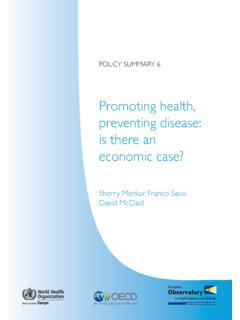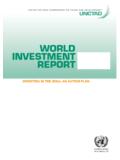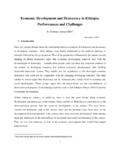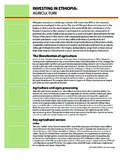Transcription of Investing in children’s health: what are the economic benefits?
1 777 Bulletin of the world health organization | October 2005, 83 (10)Abstract This paper argues that Investing in children s health is a sound economic decision for governments to take, even if the moral justifications for such programmes are not considered. The paper also outlines dimensions that are often neglected when public investment decisions are taken. The conclusion that can be drawn from the literature studying the relationship between children s health and the economy is that children s health is a potentially valuable economic investment. The literature shows that making greater investments in children s health results in better educated and more productive adults, sets in motion favourable demographic changes, and shows that safeguarding health during childhood is more important than at any other age because poor health during children s early years is likely to permanently impair them over the course of their life.
2 In addition, the literature confirms that more attention should be paid to poor health as a mechanism for the intergenerational transmission of poverty. children born into poor families have poorer health as children , receive lower investments in human capital, and have poorer health as adults. As a result, they will earn lower wages as adults, which will affect the next generation of children who will thus be born into poorer Child welfare/economics; Investments; Education; health status; Socioeconomic factors; Demography; Anthropometry; Cost-benefit analysis/methods; Longitudinal studies; Review literature (source: MeSH, NLM).Mots cl s Protection enfance/ conomie; Investissement; Enseignement et ducation; Etat sanitaire; Facteur socio conomique; D mographie; Anthropom trie; Analyse co t b n fice/m thodes; Etude longitudinale; Revue de la litt rature (source: MeSH, INSERM).Palabras clave Bienestar del ni o/econom a; Inversiones; Estado de salud; Factores socioecon micos; Demograf a; Antropometr a; An lisis de costo-beneficio/m todos; Estudios longitudinales; Literatura de revisi n (fuente: DeCS, BIREME).
3 Bulletin of the world health organization 2005;83 page 783 le r sum en fran ais. En la p gina 783 figura un resumen en espa Human Development Unit, South Asia Region, world Bank, 1818 H Street, Washington, DC 20008, USA. Correspondence should be sent to this author (email: world Bank, on secondment from WHO, Washington, DC, world Bank, Washington, DC, USA. Ref. No. 04-019232(Submitted: 01 November 2004 Final revised version received: 26 April 2005 Accepted: 10 May 2005) Investing in children s health : what are the economic benefits?Paolo C. Belli,1 Flavia Bustreo,2 & Alexander Preker3 IntroductionAlmost 11 million children die each year from preventable and curable diseases (1). The majority of these children live in low-income countries and belong to disadvantaged socioeconomic groups. There are several cost-effective interventions that could significantly reduce mortality among children but the use of these interventions is largely insufficient, particularly in coun-tries where they are most needed.)
4 The Bellagio Study Group on Child Survival has called for an increase in investments in child health , basing their call on moral and public health grounds (2). We support their call and add an additional reason to invest in children s health : the potentially vast economic benefits that may accrue from these argue that Investing in children s health is a sound economic decision for governments to take, even if the moral justifications for such programmes are not considered. We also outline dimensions that are often neglected when public in-vestment decisions are paper critically discusses the findings of the literature, pointing out inadequacies in existing economic evaluation studies and presenting the methodological advances made over the past decade. We searched the literature using the follow-ing online databases and web sites: POPLINE, Institut de l Information Scientifique et Technique , Medline, LexisNexis, JSTOR (Journal Storage, a database of literature on economics and other disciplines) and EconLit (a database of literature on economics).
5 We also reviewed publications of the world health organization (including the Commission on Macro-economics and health ), the world Bank, the Inter-American Development Bank, other regional development banks, the United Nations, the United Nations children s Fund, the United Nations Development Programme, the United States Department of health and Human Services and the Centers for Disease Control and Prevention. We have tried to focus on articles published in peer-reviewed journals. However, much 778 Bulletin of the world health organization | October 2005, 83 (10)Policy and PracticeEconomic benefits of Investing in child health Paolo C. Belli et the literature on programmes and their evaluation has been produced by agencies, such as development banks, and we de-cided that excluding this material would significantly limit the depth and scope of our analysis. We have cited only documents that are in the public domain and that appeared with a reference number (which typically implies an element of peer review and quality control).
6 The key words used in the search were: health , child(ren), sant , enfant(s), child health , economic (s), develop-ment, economic benefits, health benefits, growth, investment, human capital, family planning, developing country, economic costs, health care policy. For a full presentation of all reviewed articles, please see Belli and Appaix (3).In the first part of the paper we present the findings of the early literature that studied the association between children s health and economic development. (Early literature is defined as documents published up until the mid-1990s.) We then discuss the methodological limitations of these early studies and how later researchers have addressed these constraints by focusing on short-term benefits and social benefits and by using proxies for measuring children s health . Finally, we present the most recent and methodologically robust cost benefit analysesMost of the early studies linking interventions to improve children s health with economic benefit focused on nutri-tion.
7 Three examples of such early studies are a cost benefit study of a protein-supplementation programme for severely malnourished infants in Chile by Selowsky (4), an analysis of a vitamin A supplementation programme in the Philippines by Popkin et al. (5), and an analysis of a supplemental feeding programme targeted at moderately malnourished and severely malnourished children in Tamil Nadu, India, by Knudsen (6). All three studies evaluated the effects of nutritional programmes on children s future earning the study in Chile, Selowsky articulated a full cost benefit analysis by linking the effects of a nutritional interven-tion on 33 severely malnourished children s weight, intellectual capacity and future earnings. Comparing the rates of return of the protein supplementation programme (19 25%) with the returns on education (17% for primary education) and physical capital investments (15%) in Chile, Selowsky concluded that Investing in supplementation programmes would be one of the more productive investments that the Chilean government could undertake.
8 He also showed that the consequences of failing to provide adequate nutrition to children at an early age were et al. considered the social benefit of the reduc-tion in medical treatment costs for children suffering from severe vitamin A deficiency that resulted from a supplementa-tion estimated the increase in earnings resulting from improvements in cognitive development and children staying in school for longer that were brought about by a supplemental feeding programme. He estimated that on average the increase in earnings potential due to the programme was 55% for severely malnourished children and for moderately malnourished children . Knudsen also considered the impact on population growth of reductions in mortality among children and longer life expectancy. The estimated overall economic rate of return for the nutrition programme under the intermediate scenario of coverage and performance was It increased to if its redistributive impact was considered, given that the pro-gramme disproportionately benefited the poor.
9 Knudsen also developed a sensitivity analysis and concluded that under all but the most pessimistic scenario the expected benefits of the programme exceeded its the decade of the 1980s and until the mid-1990s, more cost benefit studies were undertaken to evaluate the economic impact of malnutrition and interventions aimed at improving children s health , particularly nutrition interven-tions. These studies were reviewed by Behrman (7). This early literature clearly established that chronic malnutrition occur-ring during the first two years of a child s life permanently im-paired cognitive ability, height and visual acuity, thus adversely affecting productivity and earning potential throughout life. It also presented some of the early attempts to quantitatively measure the incremental economic benefit associated with interventions to improve children s health . For example, Behrman utilized a production function that linked variables for cognitive achievement, years of schooling, productivity and salaries, and he used evidence from studies of urban dwellers in Kenya and Tanzania by Boissiere et al.
10 (8) and from Ghana by Glewwe (9). He estimated that the lifetime present-value productivity gain from preventing blindness (through vitamin A supplementation) could be as large as US$ 1840 per child and that an iron supplementation programme that positively affects cognitive ability (10) could potentially bring about in-creases in future wages on the order of 13 25%.One good example of the methods utilized in several of the first-generation cost benefit studies is represented by the evaluation of the economic benefits of the Integrated Child Development Project in Bolivia by Van der Gaag and Tan (11). The authors developed complex methods to estimate economic returns. Their findings are based on crucial hypotheses at three levels: first, the programme is effective in improving health out-comes; second, health gains achieved by the programme have an impact on education, and third, education yields economic returns.














